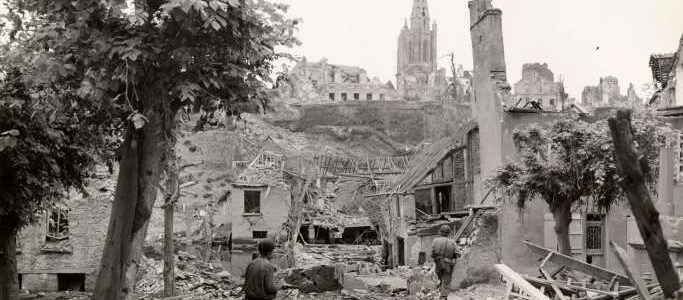
Cities Destroyed By the US in World War II
Throughout the course of World War II, many cities were reduced to ruins, whether by the Allies or the Axis Powers. Air raids and ground battles leveled cities, creating shocking hellscapes of the once thriving metropolises.
After the war, the reconstruction and healing process in these cities began. The destruction prompted conversations on war ethics, peacebuilding, and international relations that continue to this day.
To identify the cities destroyed by the United States during WWII, 24/7 Wall St. used a variety of historical sources to confirm the dates, locations, and affected area of the cities most devastated by the bombing campaigns of the United States and the other Allied nations. We considered cities where over 50% of the city was destroyed or that had significant reported casualties.
The bombing of Dresden, though not at the top of the list, is one of the most famous and controversial entries. The Allies bombing of the city in February 1945 virtually obliterated the thriving cultural center that held little military significance. Over a few days of relentless bombing, the Allies dropped thousands of tons of incendiary and explosive bombs, creating a firestorm that killed approximately 25,000 people and laid waste to a significant portion of the city. (Here are WWII bombings that involved the most planes.)
Perhaps the most famous bombings from this era were the atomic bombings of Hiroshima and Nagasaki by the United States in August 1945. Introducing the world to the horrifying power of nuclear weaponry, Hiroshima became the first target on Aug. 6, followed by Nagasaki on Aug. 9. The bombs, nicknamed “Little Boy” and “Fat Man,” caused unprecedented destruction, triggering ethical questions surrounding the use of nuclear weapons in war.
Noticeably, most of the attacks and bombings of Axis cities took place in either 1944 or 1945, towards the tail end of the war, when the Allied Forces had finally turned the tide in their favor in both the European and Pacific Theaters. D-Day took place on June 6, 1944, giving the Allies a stronger foothold in Europe that allowed for more operations in the continent.
In the Pacific Theater, the turning point for the U.S. campaign was at the Battle of Midway in June 1942, but it would take more time to cover the vast distance of the Pacific Ocean to stage attacks on the home islands of Japan. (These are the biggest american naval battles of WWII.)
Here is a look at the cities destroyed by the United States in World War II.
Sponsored: Tips for Investing
A financial advisor can help you understand the advantages and disadvantages of investment properties. Finding a qualified financial advisor doesn’t have to be hard. SmartAsset’s free tool matches you with up to three financial advisors who serve your area, and you can interview your advisor matches at no cost to decide which one is right for you. If you’re ready to find an advisor who can help you achieve your financial goals, get started now.
Investing in real estate can diversify your portfolio. But expanding your horizons may add additional costs. If you’re an investor looking to minimize expenses, consider checking out online brokerages. They often offer low investment fees, helping you maximize your profit.
Source: Read Full Article